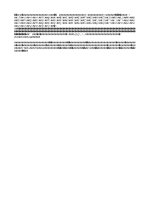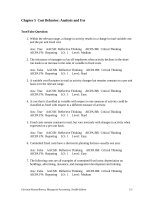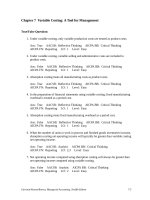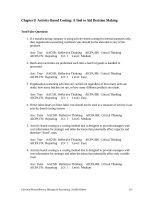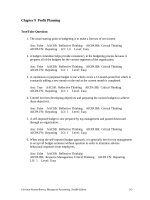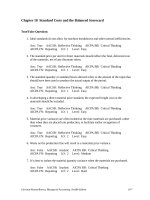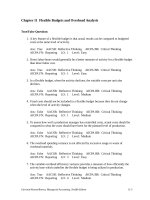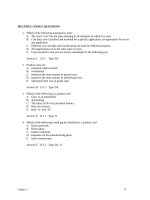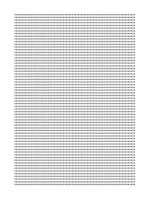Test bank managerial accounting by lauderbach 10e ch05
Bạn đang xem bản rút gọn của tài liệu. Xem và tải ngay bản đầy đủ của tài liệu tại đây (39.4 KB, 22 trang )
CHAPTER 5:
SHORT-TERM DECISIONS AND ACCOUNTING INFORMATION
Multiple Choice
a
1. The salary or wage that you could be earning while you are taking this
test is
a. an opportunity cost.
b. a sunk cost.
c. an incremental cost.
d. a joint cost.
d
2. The kind of cost that can be ignored in short-term decision making is
a. a differential cost.
b. an opportunity cost.
c. a relevant cost.
d. a sunk cost.
b
3. The role of sunk costs in decision making can be summed up in which of
the following sayings?
a. Nothing ventured, nothing gained.
b. Bygones are bygones.
c. A penny saved is a penny earned.
d. The love of money is the root of all evil.
c
4. Allocated costs are
a. generally separable.
b. generally variable.
c. generally common.
d. especially important in deciding whether to drop a segment.
a
5. The Robinson-Patman Act forbids charging different prices to different
customers unless
a. the price differences are justified by differences in distribution
costs.
b. prices offered competitors are fully disclosed to all customers.
c. such prices produce profits no greater than normal profits.
d. the customers are located within the seller's state.
c
6. A product should be dropped if
a. it has a negative incremental profit.
b. it has a negative contribution margin.
c. dropping it will increase the total profit of the company.
d. it is not essential to the company's product line.
a
7. From its refining process an oil company obtains three products, one of
which can be processed further into a different product, the other two
of which can be sold after further refining. The refining process is
a. a joint process.
b. a mixed cost process.
54
c. an unavoidable process.
d. a process whose costs should be allocated to the resulting products.
55
b
8. The Accessories Department shows sales of $35,000. Variable costs are
$30,000 and allocated unavoidable fixed costs are $9,000, leaving a
$4,000 loss. Based on this information and all other things equal,
a. the department contributes $35,000 to total profits.
b. dropping the department will reduce total company profits by $5,000.
c. the department should be closed.
d. the department should be kept only if unit volume can be increased
enough to increase sales by $4,000.
d
9. A major factor in evaluating a special order is
a. the expected contribution margin on the order.
b. the possible effects on sales at regular prices.
c. the availability of capacity to produce the additional units.
d. all of the above.
a 10. Which of the following is true for a make-or-buy decision?
a. The reliability of the outside supplier of the component is important
to the decision.
b. Depreciation on equipment used in making the component and having no
other use is the critical factor in the decision.
c. Opportunity costs are irrelevant.
d. The company should make the component if the purchase price is less
than the per-unit variable cost to make the component.
b 11. Which of the following costs is relevant in deciding whether to sell
joint products at split-off or process them further?
a. The unavoidable costs of further processing.
b. The avoidable costs of further processing.
c. The variable cost of operating the joint process.
d. The cost of materials used to make the joint products.
b 12. A manufacturing process that invariably produces two or more products
a. is a complementary process.
b. is a joint process.
c. normally has only fixed costs.
d. usually has primarily variable costs.
d 13. Which of the following is a short-term decision in which opportunity
costs are not relevant?
a. Make-or-buy decision.
b. Special-order decision.
c. Drop-a-segment decision.
d. None of the above.
c 14. Which of the following is a true statement?
a. Theory of Constraints is useful for identifying physical constraints
but cannot incorporate nonphysical constraints.
b. Theory of Constraints is useful in analyzing internal constraints but
cannot identify external constraints.
c. Constraints may be either internal or external.
d. Internal constraints are physical while external constraints are
imaginary.
56
b 15. A company has space that it uses to make a component. It could rent the
space to another company. The rent is
a. a sunk cost.
b. an opportunity cost.
c. a joint cost.
d. an avoidable cost.
a 16. Escanaba Company has 200 units of an obsolete component. The variable
cost to produce them was $10 per unit. They could now be sold for $1.75
each and it would cost $7.60 to make them now. If the units could be
used to make a product for a special order, their relevant cost is
a. $ 1.75.
b. $ 7.60.
c. $10.00.
d. some other number.
c 17. In
a.
b.
c.
d.
a make-or-buy decision, which of the following is true?
Variable costs are the only relevant costs.
Allocated fixed costs are relevant.
Alternative uses of space and machinery are relevant.
Making is the correct decision when there is idle capacity.
a 18. The best characterization of an opportunity cost is that it is
a. relevant to decision making but is not usually reflected in
accounting records.
b. not relevant to decision making and is not usually reflected in
accounting records.
c. relevant to decision making and is usually reflected in accounting
records.
d. not relevant to decision making and is usually reflected in
accounting records.
a 19. A sunk cost is
a. not avoidable.
b. avoidable under one alternative but not under another.
c. joint or common.
d. direct to a segment.
b 20. Differential costs are costs that are
a. not avoidable.
b. avoidable under one alternative but not under another.
c. joint or common.
d. not direct to a segment.
a 21. A common cost
a. relates to a process that produces more than one product.
b. should be allocated to the segments of a company.
c. can usually be avoided in its entirety by dropping a segment.
d. none of the above.
a 22. An
a.
b.
c.
opportunity cost commonly associated with a special order is
the contribution margin on lost sales.
the variable costs of the order.
additional fixed costs related to the increased output.
57
d. any of the above.
58
b 23. Which of the following statements pertaining to the Theory of
Constraints is true?
a. Inventory is evil and should never be kept.
b. Inventory is important to keep immediately before a bottleneck
process.
c. Inventory should be kept before every machining process to prevent
any downtime.
d. None of the above are true.
c 24. Which of the following cost-classification schemes is most relevant to
decision making?
a. Fixed--variable.
b. Joint--common
c. Avoidable--unavoidable.
d. Direct--common.
d 25. Which of the following is NOT relevant in deciding whether to process a
joint product beyond its split-off point?
a. The split-off value.
b. The price after additional processing.
c. The cost of further processing.
d. The cost of operating the joint process.
c 26. Benson Company has 200 units of an obsolete part. The variable cost to
produce them was $4 per unit. They could now be sold for $3 each and it
would cost $6 to make them now. The parts could be reworked for $8 each
and sold for $17. What is the monetary advantage of reworking the parts
over the next-best action?
a. $ 600.
b. $1,000.
c. $1,200.
d. $2,000.
b 27. Pueblo Company sells a product for $60. Variable cost is $32. Pueblo
could accept a special order for 1,000 units at $46. If Pueblo accepted
the order, how many units could it lose at the regular price before the
decision became unwise?
a. 1,000.
b. 500.
c. 200.
d. 0.
c 28. Which of the following is NOT a short-term decision?
a. Accept a special order.
b. Make-or-buy a component.
c. Replace a machine.
d. Sell a joint product at split-off or process it further.
d 29. The variable cost
a. an incremental
b. an opportunity
c. a differential
d. a sunk cost.
of a unit of product made yesterday is
cost.
cost.
cost.
59
d 30. The most profitable use of a resource that has limited capacity and is
needed in the production of more than one product is a function of which
of the following?
a. The number of units of each product the company can sell.
b. The contribution margin of each product.
c. The amount of resource-use required for each unit of each product.
d. All of the above.
c 31. Which of the following is NOT relevant in a make-or-buy decision about a
part the entity uses in some of its products?
a. The reliability of the outside supplier.
b. The alternative uses of owned equipment used to make the part.
c. The outside supplier's per-unit variable cost to make the part.
d. The number of units of the part needed each period.
d 32. Which of the following is NOT relevant to a decision about whether to
drop a segment?
a. The contribution margin expected to be produced by the segment.
b. The avoidable fixed costs direct to that segment.
c. The complementary effects of dropping the segment.
d. "None of the above" is the best answer because all of the above are
relevant.
a 33. Just-in-time manufacturers are less likely than conventional
manufacturing companies to
a. operate a joint process that results in joint products.
b. be able to accommodate special orders.
c. have constraints on their productive capacity.
d. fit any of the above characterizations.
d 34. The total demand for Product Z is relevant to a decision about
a. the best use of a resource that is in limited supply and is used in
the production of Product Z and one other of the company's products.
b. whether to sell Product Z, a joint product, at split-off or process
it further into another salable product.
c. replacing Product Z with another product.
d. all of the above decisions.
c 35. Buchanan Company currently sells 4,000 units of product Q for $1 each.
Capacity is 5,000 units. Variable costs are $0.40 and avoidable fixed
costs are $400. A chain store has offered $0.80 per unit for 400 units
of Q. If Buchanan accepts the order, the change in income will be a
a. $60 decrease.
b. $80 decrease.
c. $160 increase.
d. $480 increase.
a 36. Tyler Company currently sells 1,000 units of product M for $1 each.
Variable costs are $0.40 and avoidable fixed costs are $400. A discount
store has offered $0.80 per unit for 400 units of product M. The
managers believe that if they accept the special order, they will lose
some sales at the regular price. Determine the number of units they
could lose before the order became unprofitable.
a. 267 units
60
b. 500 units
c. 600 units
d. Some other number.
b 37. Bear Valley produces three products: A, B, and C. One machine is used
to produce the products. The contribution margins, sales demands, and
time on the machine (in minutes) are as follows:
time on
Demand
CM
machine
---------------A
100
$25
10
B
80
18
5
C
150
30
10
There are 2400 minutes available on the machine during the week.
many units should be produced and sold to maximize the weekly
contribution?
A
B
C
a. 100 80 150
b. 50 80 150
c. 90
0 150
d. 100 80 100
How
d 38. Elk Grove produces three products: A, B, and C. A machine is used to
produce the products. The contribution margins, sales demands, and time
on the machine (in minutes) are as follows:
time on
Demand
CM
machine
---------------A
120
$20
5
B
80
36
10
C
100
50
15
There are 2400 minutes available on the machine during the week.
many units should be produced and sold to maximize the weekly
contribution?
A
B
C
a. 120 80 100
b. 20 80 100
c. 120 30 100
d. 120 80
66
61
How
a 39. Black Oak Company makes and sells oak boxes for a price of $60
each. Unit costs based on anticipated monthly sales of 1,000 boxes
are as follows:
Direct material cost
Direct labor cost
Variable manufacturing overhead
Variable selling overhead
Fixed costs
$15
12
3
5
2
A chain store has offered to buy 100 boxes per month at $58 each.
To accept this special order, Black Oak will have to restrict its
sales to regular customers to only 900 boxes per monthly because
its production capacity cannot be expanded in the short run.
However, no variable selling expenses will be incurred for this
special order. If Black Oak accepts the chain store's offer, its
profit will
a. increase by $300.
b. increase by $500.
c. decrease by $200.
d. decrease by $500.
a 40. Medford Corporation operates a plant with a productive capacity to
manufacture 20,000 units of its product a year. The follow information
pertains to the production costs at capacity:
Variable costs
Fixed costs
Total costs
$160,000
240,000
-------$400,000
=========
A supplier has offered to sell 4,000 units to Medford annually. Assume
no change in the fixed costs. What is the price per unit that makes
Medford indifferent between the "make" and "buy" options?
a. $8
b. $12
c. $20
d. $0
62
b 41. DJH Company produces 1,000 units of Part X per month. The total
manufacturing costs of the part are as follows:
Direct materials
Direct labor
Variable overhead
Fixed overhead
Total manufacturing cost
$10,000
15,000
5,000
30,000
------$60,000
=======
An outside supplier has offered to supply the part at $40 per unit. It
is estimated that 20% of the fixed overhead assigned to Part X will no
longer be incurred if the company purchases the part from the outside
supplier. If DJH Company purchases 1,000 units of Part X from the
outside supplier per month, then its monthly operating income will
a. decrease by $20,000.
b. decrease by $4,000.
c. not change.
d. increase by $20,000.
c 42. DJH Company produces 1,000 units of Part X per month. The total
manufacturing costs of the part are as follows:
Direct materials
Direct labor
Variable overhead
Fixed overhead
Total manufacturing cost
$10,000
15,000
5,000
30,000
------$60,000
=======
An outside supplier has offered to supply the part at $40 per unit. It
is estimated that 20% of the fixed overhead assigned to Part X will no
longer be incurred if the company purchases the part from the outside
supplier. What is the maximum price that DJH Company should be willing
to pay the outside supplier?
a. $60
b. $40
c. $36
d. $25
63
c 43. Scooter Company produces three products from a joint process costing
$100,000. The following information is available:
A
B
C
Costs to
Process
Further
------$70,000
$30,000
$90,000
Selling Price
Units at Split-off
----- -----------10,000
$35
20,000
$40
30,000
$20
Selling Price
After Further
Processing
---------$40
$45
$25
Which products should be processed further?
a. A only.
b. A and B.
c. B and C.
d. A, B, and C.
b 44. Genco Company produces three products from a joint process costing
$100,000. The following information is available:
A
B
C
Units
----2,000
3,000
5,000
Costs to
Process
Further
------$60,000
$60,000
$80,000
Selling Price
at Split-off
-----------$25
$30
$40
Selling Price
After Further
Processing
--------$50
$45
$60
Which products should be sold without further processing?
a. B only.
b. A and B.
c. B and C.
d. A, B, and C.
c 45. Colfax Company expects to incur the following costs at the planned
production level of 10,000 units:
Direct materials $100,000
Direct labor
120,000
Variable overhead
60,000
Fixed overhead
30,000
The selling price is $50 per unit. The company currently operates at
full capacity of 10,000 units. Capacity can be increased to 13,000 units
by operating overtime. Variable costs increase by $14 per unit for
overtime production. Fixed overhead costs remain unchanged when overtime
operations occur. Colfax Company has received a special order from a
wholesaler who has offered to buy 1,000 units at $45 each. What is the
incremental cost associated with this special order?
a. $14,000
b. $28,000
c. $42,000
d. $45,000
64
b 46. Colfax Company expects to incur the following costs at the planned
production level of 10,000 units:
Direct materials $100,000
Direct labor
120,000
Variable overhead
60,000
Fixed overhead
30,000
The selling price is $50 per unit. The company currently operates at
full capacity of 10,000 units. Capacity can be increased to 13,000 units
by operating overtime. Variable costs increase by $14 per unit for
overtime production. Fixed overhead costs remain unchanged when overtime
operations occur. Colfax Company has received a special order from a
wholesaler who has offered to buy 1,000 units at $45 each. What is the
impact on Colfax's operating income if this special order is accepted?
a. $17,000 increase
b. $3,000 increase
c. no change
d. $5,000 decrease
c 47. GMH Company manufactures 100,000 units of Part X annually for use in one
of its main products. The total manufacturing cost for 100,000 units of
Part X is as follows:
Direct materials
Direct labor
Variable overhead
Fixed overhead
Total cost
$120,000
80,000
40,000
160,000
------$400,000
========
Selin Company has offered to sell GMH 100,000 units of Part X per year.
If GMH accepts this offer, the facilities used to produce Part X can be
used in the production of other components. This change would save GMH
$10,000 in rent for the leased production facility used at present to
support the production of other components. What is the amount of
relevant costs for this make-or-buy decision?
a. $200,000
b. $240,000
c. $250,000
d. $400,000
65
d 48. GMH Company manufactures 100,000 units of Part X annually for use in one
of its main products. The total manufacturing cost for 100,000 units of
Part X is as follows:
Direct materials
Direct labor
Variable overhead
Fixed overhead
Total cost
$120,000
80,000
40,000
160,000
-------$400,000
========
Sutton Company has offered to sell GMH 100,000 units of Part X per year.
If GMH accepts this offer, the facilities used to produce Part X can be
used in the production of other components. This change would save GMH
$10,000 in rent for the leased production facility used at present to
support the production of other components. What is the maximum price
that GMH should be willing to pay Sutton for part X?
a. $1.20
b. $2.00
c. $2.40
d. $2.50
d 49. Barrie, Inc., produces three products: A, B, and C. Two machines are
used to produce the products. The contribution margins, sales demands,
and time on each machine (in minutes) is as follows:
time
time
Demand
CM
on M1
on M2
A
100
$12
5
10
B
80
18
10
5
C
100
25
15
5
There are 2,400 minutes available on each machine during the week.
many units should be produced and sold to maximize the weekly
contribution?
A
B
C
a. 100 80 100
b. 20 80 100
c. 100 40 100
d. 100 80
73
66
How
b 50. Barrie, Inc., produces three products: A, B, and C. Two machines are
used to produce the products. The contribution margins, sales demands,
and time on each machine (in minutes) is as follows:
time
time
Demand
CM
on M1
on M2
A
100
$12
5
10
B
80
18
10
5
C
150
25
5
10
There are 2,400 minutes available on each machine during the week.
many units should be produced and sold to maximize the weekly
contribution?
A
B
C
a. 100 80 150
b. 50 80 150
c. 90
0 150
d. 100 80 100
How
True-False
F
1. If the results of a decision are not as good as expected, there has been
an error in the decision-making process.
T
2. The costs of operating a joint process can be fixed or variable.
T
3. Incremental costs can be either fixed or variable.
T
4. In general, the smaller the segment being considered in a decision, the
fewer the avoidable costs.
T
5. A given fixed cost might be separable and relevant for the purpose of
one decision and common and irrelevant for the purpose of another
decision in the same company.
F
6. Opportunity cost is usually the amount paid for a resource.
T
7. Fixed costs that are allocated to several segments are normally
irrelevant to decisions for one of those segments.
T
8. The only revenues or costs that are relevant in decision making are the
differential revenues or costs.
T
9. Constraints may be internal to the firm or external to the firm.
T 10. Management's objective should be to exploit a constraint rather than to
eliminate it.
67
Problems
1. Wilson Company expects the following results, without considering any of
the changes described below.
Product A Product B
Total
--------- ------------Sales
$100
$300
$400
Variable costs
40
100
140
---------Contribution margin
$ 60
$200
$260
Fixed costs - avoidable
(20)
(30)
(50)
- unavoidable
(50)
(100)
(150)
---------Profit (loss)
$(10)
$ 70
$ 60
=====
====
====
The unavoidable costs are allocated based on unit sales of 1,000 A and
2,000 B. CONSIDER EACH QUESTION INDEPENDENTLY UNLESS TOLD OTHERWISE.
a. Compute Wilson's income if product A is dropped.
b. If product A were dropped and the unit sales of product B increased by
30%, what would the company's income be?
c. Product A can be dropped and replaced with a new product, C, which would
have avoidable fixed costs of $50. Product C would sell for $0.60, have
variable costs of $0.20, and expected volume of 400 units. Compute
Wilson's income if A were replaced by C.
d. Suppose now that products A and B are joint products that are being sold
at split-off. All of the costs shown on the income statement are the
materials, labor, and overhead of the joint process. Find income if
product B were processed further at additional costs of $90 and sold for
$350.
SOLUTION:
a. Wilson's income:
$20
($200 CM from B - $30 - $150)
b. Wilson's income:
$80
($260 CM from B - $30 - $150)
c. Wilson's income:
$130
[$20 + 400($0.60 - $0.20) - $50]
d. Wilson's income: $20
($60 CM from A + $50 incremental revenue –
$90 incremental cost)
68
2. Arapahoe Corp. can make three products from a joint process. The monthly
cost of the joint process is $10,000. Following are data about the three
products.
Product
------A
B
C
Sales Value
at
Split-off Point
--------------$ 8,000
$ 9,000
$
0
Sales Value
if Further
Processed
----------$12,000
$10,000
$ 2,500
Costs of
Additional
Processing
---------$2,500
$2,000
$1,000
a. Which product(s) should be sold at the split-off point?
b. Arapahoe is currently processing all three products rather than selling
any of them at the split-off point. Find its current income.
SOLUTION:
a. Product B should be sold at split-off.
b. Income: $9,000
$10,000)
($12,000 + $10,000 + $2,500 - $2,500 - $2,000 - $1,000 -
3. Madison Co. operates a joint process. Three products, B, C, and D emerge
from that process, each of which can be sold immediately or processed
further. Monthly output is 50,000 gallons; 50% is B, 30% is C, and 20% is
D. You have the following information.
B
C
D
------------------Per-gallon split-off price
$ 8
$ 9
$ 6
Per-gallon price after further
processing
$13
$15
$12
Per-gallon variable cost of
further processing
$ 4
$ 2
$ 4
Avoidable direct fixed costs of
further processing, per month
$35,000
$45,000
$18,000
Unavoidable direct fixed costs
of further processing, per month $18,000
$40,000
$ 7,000
Which product(s), if any, should be sold at split-off?
SOLUTION:
B should be sold at split-off.
B: [50,000 x 50%] x [$13 - $8 - $4] - $35,000 = -$10,000
C: [50,000 x 30%] x [$15 - $9 - $2] - $45,000 = $15,000
D: [50,000 x 20%] x [$12 - $6 - $4] - $18,000 = $2,000
69
4. Milton Company has three products: A, B, and C. Three machines are used to
produce the products. The contribution margins, sales demands, and time on
each machine (in minutes) is as follows:
A
B
C
Demand
100
80
60
time
on M1
10
10
5
CM
$45
$30
$40
time
on M2
15
5
10
time
on M3
12
8
5
There are 2,400 minutes available on each machine during the week. All
materials needed are readily available on a just-in-time basis.
a. What are the load factors for each of the three machines?
b. Which machine is the bottleneck?
c. How many units of A, B, and C should be produced during the week?
SOLUTION:
a. M1: 87.5% [(10 x 100) + (10 x 80) + (5 x 60)]/2,400
M2: 104.2% [(15 x 100) + (5 x 80) + (10 x 60)]/2,400
M3: 89.2% [(12 x 100) + (8 x 80) + (5 x 60)]/2,400
b. The bottleneck is M2 as identified by the load factor exceeding 100%
c. A:
A:
B:
C:
93, B:
$45/15
$30/5
$40/10
80, C: 60
= $3
= $6
= $4
Time available
2,400
Produce B first 80 x 5 =
400
Time remaining
2,000
Produce C: 60 x 10 =
600
Time remaining
1,400
Produce A 93 x 15
1,395
Time remaining
5
70
5. LaCrosse Company expects the following results, without considering any of
the changes described below.
Product A
Product B
Total
---------------------Sales
$1,000
$3,000
$4,000
Variable costs
400
1,000
1,400
------------Contribution margin
$ 600
$2,000
$2,600
Fixed costs - avoidable
(200)
(300)
(500)
- unavoidable
(500)
(1,000)
(1,500)
-------------Profit (loss)
$ (100)
$ 700
$ 600
=====
======
======
The unavoidable costs are allocated based on unit sales of 1,000 A and
2,000 B. An exporter has offered $0.80 per unit for 200 units of A.
a. Find the change in income if LaCrosse accepts the order, assuming no
loss of regular sales.
b. The managers believe that if they accept the special order, they will
lose some sales at the regular price. Determine the number of units
they could lose before the order became unprofitable.
c. The managers believe that they will lose 80 units at the regular price
if they accept the order. Calculate the price they must charge for the
special order to increase income by $50.
SOLUTION:
a. Change in income: $80 increase [200 x ($0.80 - $0.40 variable cost per
unit)]
b. Sales to lose:
133 units
[$80/($1.00 - $0.40)] = 133
c. Price: $0.89
Lost contribution margin (80 x $0.60)
Desired profit
Contribution margin required from special order
Divided by 20. units
Equals contribution margin per unit
Plus variable cost
Equals required price
71
$48.0
50.0
----$98.0
200
----$0.49
0.40
----$0.89
=====
6. Mays Company manufactures 200,000 units of part XYZ annually. The following
information has been collected:
Materials
Direct labor
Variable overhead
Fixed overhead
Total costs
$200,000
110,000
50,000
100,000
-------$460,000
========
Clemens Company has offered to provide part XYZ for $2 per unit. Assume no
other productive use of the space exists.
a. What would be the dollar impact if Mays accepted the offer?
b. What is the maximum price Mays is willing to pay for the part?
SOLUTION:
a. $40,000 less profits
($360,000 make - $400,000 buy)
Cost to buy the part: 200,000 x $2 = $240,000
Cost to make the part: $200,000 + 110,000 + 50,000 = $360,000
b. $1.80
($360,000/200,000)
7. Gonzalez can produce any of three products with its current production
line. The heat treating equipment has 400 hours available during any given
month. Per unit production, sales, and cost statistics are as follows:
A
B
C
------Selling price
$15
$20
$10
Variable cost
$ 9
$12
$ 7
Required time in heat treat
1.5 hrs 2.5 hrs. 1.0 hrs
Maximum demand per month
100
100
100
a. How many of each product should Gonzalez produce and sell?
b. Suppose the selling price of C increases to $12. How many of each
product should Gonzalez produce and sell?
SOLUTION:
a. 100 A, 100 B, 0 C
A: ($15 - 9)/1.5 = $4.00/hr
B: ($20 - 12)/2.5 = $3.20/hr
C: ($10 - 7)/1.0 = $3.00/hr
100 x 1.5 hrs = 150.0 hrs
100 x 2.5 hrs = 250.0
0 (no hours remaining)
b. 100 A, 60 B, 100 C
72
C: ($12
A: ($15
B: ($20
8. Scottso
- 7)/1.0 =
- 9)/1.5 =
- 12)/2.5 =
Enterprises
$5.00/hr
100 x 1.0 hrs = 100.0 hrs
$4.00/hr
100 x 1.5 hrs = 150.0
$3.20/hr
(400 - 100 - 150)/2.5 hrs = 60 units
has the following products and costs:
Unit demand per month
Selling price
Materials
Labor and overhead
Sales commission
A
2,000
B
3,000
C
4,000
$500
150
180
50
$600
300
210
75
$800
350
300
100
Labor and overhead are applied to each product at a rate of $30 per machine
hour. Management considers both labor and overhead to be fixed costs.
a. Scottso currently has 60,000 hours available for production each month.
How many units should be produced and sold for each product?
b. An exporter has approached Scottso with an offer to purchase 500 units
of product C for a discounted price. This is a one-time order and will
not affect normal sales. No commission will be paid. What is the minimum
price Scottso should accept?
SOLUTION:
a. A: 2,000
B: 1,142
C: 4,000
Throughput/hour for A: $50
[(500 - 150 - 50)/(180/30)]
Throughput/hour for B: $32.14 [(600 - 300 - 75)/(210/30)]
Throughput/hour for C: $35
[(800 - 350 - 100)/(300/30)]
Hours available
Produce A: 2,000 x 6
Time remaining
Produce C: 4,000 x 10
Time remaining
Produce B: 1,142 x 7
Time remaining
60,000
12,000
48,000
40,000
8,000
7,994
6
b. $575
Lost throughput of B: $32.14 x 7 hours = $225
Materials
350
Minimum price
$575
73
9. Miami Company currently sells 3,000 units of product A for $1.25 each.
Variable costs are $0.60, avoidable fixed costs are $750, and unavoidable
allocated fixed costs are $1,500. An exporter has offered $0.90 per unit
for 800 units of product A.
a. Find the change in income if Miami can accept the order without
affecting current sales.
b. The managers believe that if they accept the special order, they will
lose some sales at the regular price. Determine the number of units
they could lose before the order became unprofitable.
c. The managers believe that they will lose 270 units at the regular price
if they accept the order. Calculate the price they must charge for the
special order to increase income by $200.
SOLUTION:
a. Change in income:
b. Sales to lose:
$240 increase
369 units
[800 x ($0.90 - $0.60)]
[$240/($1.25 - $0.60)] = 369
c. Price: $1.07
Lost contribution margin (270 x $0.65)
Desired profit
Contribution margin required from special order
Divided by 800 units
Equals contribution margin per unit
Plus variable cost
Equals required price
74
$175.5
200.0
----$375.5
800
----$0.47 rounded
0.60
----$1.07
=====
10. Arpeggio Company manufactures 1,000 units of part XYZ annually. The
following information has been collected:
Materials
Direct labor
Variable overhead
Fixed overhead
Total costs
$200,000
110,000
50,000
100,000
-------$460,000
========
Mobile Company has offered to provide part XYZ for $400 per unit. If
Arpeggio accepts the offer another product will be moved into the space
vacated, saving $60,000 a year in rent.
a. What would be the dollar impact if Arpeggio accepted the offer?
b. What is the maximum price Arpeggio is willing to pay for the part?
SOLUTION:
a. $20,000 more profits
($420,000 make - $400,000 buy)
Cost to buy the part: 1,000 x $400 = $400,000
Cost to make the part: $200,000 + 110,000 + 50,000 = $360,000 + 60,000 rent
= $420,000
b. $420
($420,000/1,000)
75
